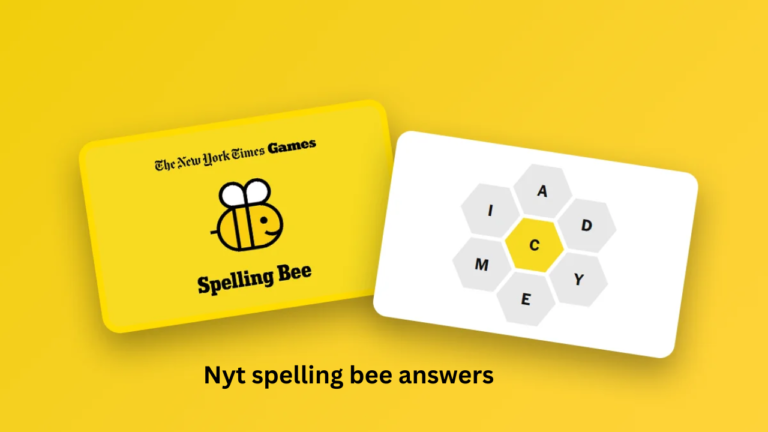The New York Times Spelling Bee is a daily word puzzle game that challenges players to find as many words as possible using seven letters. Whether you’re a seasoned word game enthusiast or someone just starting, mastering this puzzle requires strategy, patience, and a solid understanding of word patterns. In this article, we’ll break down how to approach the game, common challenges, and proven strategies to help you reach your potential and consistently score high.
Introduction: The Fascinating World of the NYT Spelling Bee
The NYT Spelling Bee, created by Joel Fagliano, has become a beloved daily puzzle for word game lovers around the world. Every day, players are tasked with creating as many valid words as they can using a set of seven letters. At least one of these words must be a 7-letter word, which unlocks the coveted “Pangram” achievement for that puzzle. It’s not just about forming random words but also about strategizing to maximize your score.
This article aims to explore the core aspects of the NYT Spelling Bee puzzle and provide insights into how to improve your game. Whether you’re struggling to find that elusive 7-letter word or looking for tips to increase your word count, this guide will give you the tools to succeed. By understanding the game’s mechanics and applying a few key strategies, you can elevate your puzzle-solving abilities and make the most out of each daily challenge.
Understanding the NYT Spelling Bee Game Mechanics

How the Game Works
The game is relatively simple to understand, but it requires sharp thinking and a deep knowledge of words. Each day, the NYT Spelling Bee puzzle provides a set of seven letters, one of which is the “center” letter that must appear in every word you form. You have a 24-hour window to solve the puzzle, with your score improving as you find more words.
The challenge lies in the variety of words you can form, as well as how you manage your time. Words can range in length, from the simplest 3-letter words to the coveted 7-letter words. To score points, the word must be at least four letters long. Each word has a score based on its length, with longer words generally yielding higher points. Forming the 7-letter word, also called the “pangram,” gives you a major boost and unlocks a perfect puzzle.
Scoring System and Letter Restrictions
Understanding the scoring system is crucial for strategic play. Words formed with the seven available letters are assigned points based on their length. Each 3- to 4-letter word gives you a base score, while longer words provide progressively higher points. The 7-letter word, or Pangram, is especially rewarding because it unlocks the maximum points available for that puzzle.
Additionally, there’s a restriction where you can’t form words that repeat letters unless they’re in the given letters set. This means that some seemingly simple words are disqualified, adding an extra layer of complexity. The key to unlocking the highest score in a given puzzle is forming as many words as possible while aiming for the 7-letter word.
Common Challenges and How to Overcome Them
Dealing with Unfamiliar Words
One of the most frustrating aspects of the NYT Spelling Bee is encountering unfamiliar words that seem impossible to crack. Whether it’s a rare verb, an obscure noun, or an unusual plural form, it’s easy to feel stuck when you can’t find the right word. A great way to overcome this challenge is by focusing on common prefixes, suffixes, and roots. For example, knowing that many English words end in “-ing” or “-ed” can help you quickly form valid words.
To expand your word bank, consider using word lists or reading more often. Exposure to different writing styles and types of literature will familiarize you with lesser-known words. This continuous learning process can help you recognize and remember new words that will serve you well in future puzzles.
Maximizing Score with Limited Time
With only 24 hours to solve the puzzle, time management becomes essential. It’s tempting to get stuck on a single word or a tricky section of the puzzle, but it’s important to balance persistence with efficiency. Start by brainstorming simpler words and gradually work your way up to more complex ones. This will help you get into the rhythm of the game and build up a solid score before tackling the harder words.
If you find yourself in a time crunch, try breaking the puzzle into smaller, manageable sections. Focus on forming all the smaller words before coming back to tackle the 7-letter word. This technique allows you to feel a sense of progress, and it’s often easier to stumble upon the larger words after you’ve already built momentum.
Effective Strategies for Solving NYT Spelling Bee Puzzles
Building a Strong Vocabulary
The foundation of any successful NYT Spelling Bee strategy is a broad vocabulary. Building your vocabulary is a gradual process, and the best way to start is by learning common prefixes, suffixes, and word roots. Words like “un-,” “pre-,” and “-ly” appear frequently in English, and knowing how to recognize them will speed up the puzzle-solving process.
Additionally, practice is key. Regularly engaging with word puzzles or playing games like Scrabble can expose you to new words and reinforce your memory. Keep a list of unusual words you encounter and revisit them regularly. Over time, you’ll begin to internalize these words, making it easier to recognize them in future puzzles.
Using Online Tools and Resources
While some may argue that using word solvers is cheating, there are legitimate ways to leverage technology to improve your game. Online word solvers and apps can help you identify valid words you might have missed, but they should be used as a learning tool rather than a crutch. By analyzing the suggestions provided by these tools, you can learn new words and improve your word-finding ability over time.
Many players use word lists or crossword solvers to get hints for tough puzzles. Additionally, websites like WordFinder and Anagram Solver can be valuable resources for practicing word formation and improving your overall spelling bee skills. Keep in mind that the true mastery of the game comes when you’re able to solve puzzles without relying on outside help.
Tracking Your Progress
Tracking your progress is an essential part of growing as a Spelling Bee player. The NYT Spelling Bee provides a score for each puzzle, allowing you to monitor improvements and spot areas where you may be struggling. If you’re consistently missing the 7-letter word or failing to reach the high score, it’s a sign that you need to adjust your strategy.
Setting achievable goals is another way to keep your progress on track. Whether it’s aiming for a higher score or simply aiming to form more words, breaking down your larger objective into smaller, measurable targets will help you stay motivated and focused.
The Science Behind the NYT Spelling Bee Puzzle
Word Patterns and Linguistic Insights
At its core, the NYT Spelling Bee is a game of pattern recognition. Being able to spot common word endings like “-ing,” “-er,” or “-ed” will increase your chances of finding more words quickly. The puzzle also rewards players who are adept at recognizing compound words or variations of a base word, such as “run” becoming “runner.”
Understanding linguistic patterns can be helpful when you’re trying to form words under time pressure. This means that developing your ability to spot familiar suffixes, prefixes, and other common language structures will give you an edge in solving puzzles faster and more efficiently.
Psychological Aspects of Puzzle Solving
The psychological aspect of puzzle-solving cannot be overlooked. When you get stuck, it’s easy to become frustrated, which can cloud your thinking and slow you down. Maintaining a positive mindset is key. Take breaks when needed, clear your mind, and approach the puzzle from a fresh angle. Psychological research shows that stepping away from a problem and returning to it later can often lead to a breakthrough moment.
Conclusion: Mastering the NYT Spelling Bee
Mastering the NYT Spelling Bee puzzle is not an overnight achievement, but with consistent practice and the right strategies, anyone can improve their skills. Start by building your vocabulary, managing your time wisely, and using online resources as educational tools. With a better understanding of word patterns and a positive mindset, you’ll find that your puzzle-solving abilities will improve dramatically. Keep challenging yourself, and soon enough, you’ll be solving the daily puzzle with confidence and ease.
FAQs
How can I improve my chances of finding the 7-letter word?
Focus on common word endings and experiment with different letter combinations. Make sure to use the center letter in every word, and look for familiar prefixes and suffixes.
Is it cheating to use online word solvers for the NYT Spelling Bee?
While it’s not technically cheating, using word solvers should be a learning tool rather than a crutch. Aim to improve your skills and only use these tools to practice or after completing the puzzle on your own.
How does the scoring system work in the NYT Spelling Bee?
Each word’s score depends on its length. Longer words earn more points, and the 7-letter word gives the highest score. The “Pangram” unlocks a perfect score for that puzzle.
What are some tips for beginners?
Start by focusing on shorter words, use the center letter in every word, and avoid getting stuck on any one word. Build a solid vocabulary and use common prefixes and suffixes.
How can I track my progress and improve my score daily?
Pay attention to your daily score and identify patterns where you tend to score lower. Track your progress by setting small goals, such as forming more words or discovering the 7-letter word.
You May Also Read: https://bignewstap.com/fundly/
